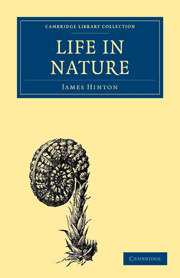Book contents
- Frontmatter
- Contents
- INTRODUCTION
- CHAPTER I OF FUNCTION; OR, HOW WE ACT
- CHAPTER II OF NUTRITION; OR, WHY WE GROW
- CHAPTER III OF NUTRITION; THE VITAL FORCE
- CHAPTER IV OF LIVING FORMS; OR, MORPHOLOGY
- CHAPTER V OF LIVING FORMS; THE LAW OF FORM
- CHAPTER VI IS LIFE: UNIVERSAL?
- CHAPTER VII THE LIVING WORLD
- CHAPTER VIII NATURE AND MAN
- CHAPTER IX THE PHENOMENAL AND THE TRUE
- CHAPTER X FORCE
- CHAPTER XI THE ORGANIC AND THE INORGANIC
- CHAPTER XII THE LIFE OF MAN
- CHAPTER XIII CONCLUSION
- APPENDIX: AN ATTEMPT TOWARDS A MORE EXTENDED INDUCTION OF THE LAWS OF LIFE
CHAPTER II - OF NUTRITION; OR, WHY WE GROW
Published online by Cambridge University Press: 29 August 2010
- Frontmatter
- Contents
- INTRODUCTION
- CHAPTER I OF FUNCTION; OR, HOW WE ACT
- CHAPTER II OF NUTRITION; OR, WHY WE GROW
- CHAPTER III OF NUTRITION; THE VITAL FORCE
- CHAPTER IV OF LIVING FORMS; OR, MORPHOLOGY
- CHAPTER V OF LIVING FORMS; THE LAW OF FORM
- CHAPTER VI IS LIFE: UNIVERSAL?
- CHAPTER VII THE LIVING WORLD
- CHAPTER VIII NATURE AND MAN
- CHAPTER IX THE PHENOMENAL AND THE TRUE
- CHAPTER X FORCE
- CHAPTER XI THE ORGANIC AND THE INORGANIC
- CHAPTER XII THE LIFE OF MAN
- CHAPTER XIII CONCLUSION
- APPENDIX: AN ATTEMPT TOWARDS A MORE EXTENDED INDUCTION OF THE LAWS OF LIFE
Summary
We are continually dying. In all our actions force is given off, the very same force by which the body lives; and portions of our frame, accordingly, waste and are cast off. This process implies an opposite one. The life, constantly ceasing, is constantly renewed. Throughout the adult state nutrition proceeds pari passu with decay; in youth it is in excess, and results in growth; in age, the preponderance of the decay predicts the end. But new life springs from the old, and in its offspring the perishing organism repeats and multiplies its youth. How is this marvel wrought? By what agency does the perpetually failing life renew itself, and rise up fresh and vigorous from its ceaseless struggle with decay?
It is a wonderful thing—Life, ever growing old, yet ever young; ever dying, ever being born; cut down and destroyed by accident, by violence, by pestilence, by famine, preying remorselessly and insatiably upon itself, yet multiplying and extending still, and filling every spot of earth on which it once obtains a footing; so delicate, so feeble, so dependent upon fostering circumstances and the kindly care of nature, yet so invincible; endowed as if with supernatural powers, like spirits of the air, which yield to every touch and seem to elude our force; subsisting by means impalpable to our grosser sense, yet wielding powers which the mightiest agencies obey.
- Type
- Chapter
- Information
- Life in Nature , pp. 35 - 58Publisher: Cambridge University PressPrint publication year: 2009First published in: 1862



